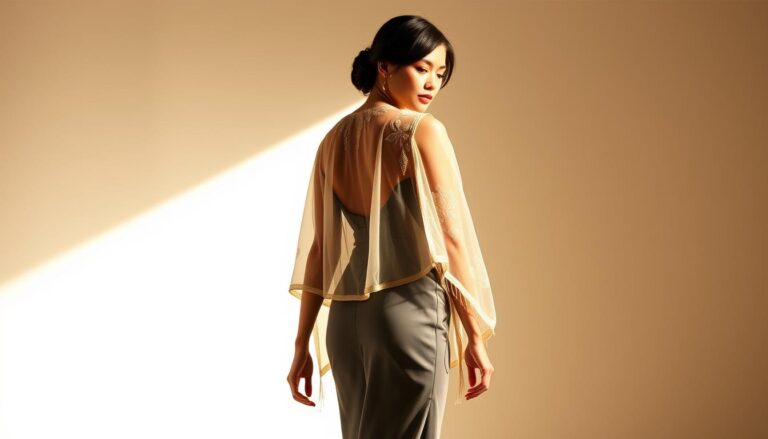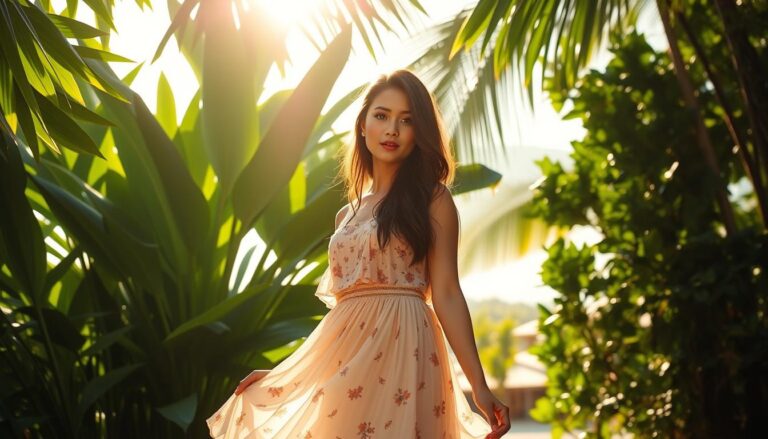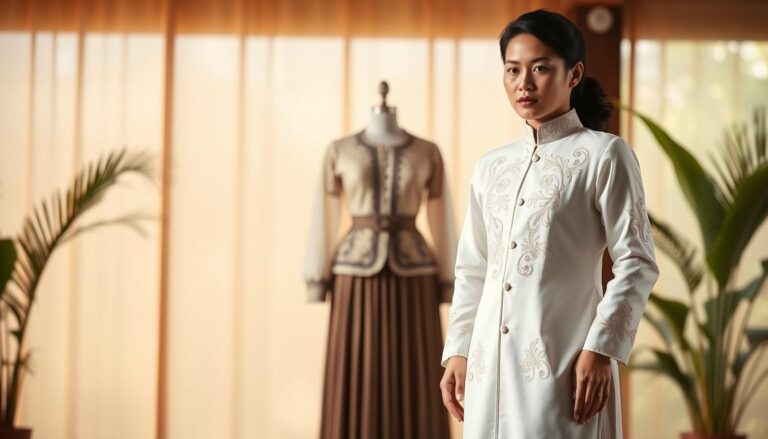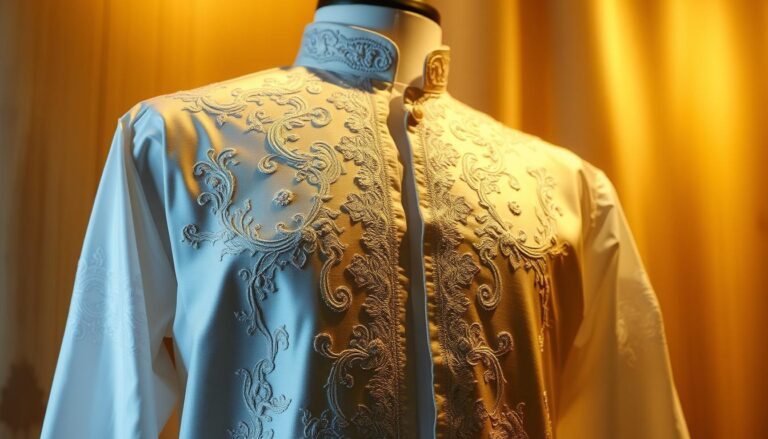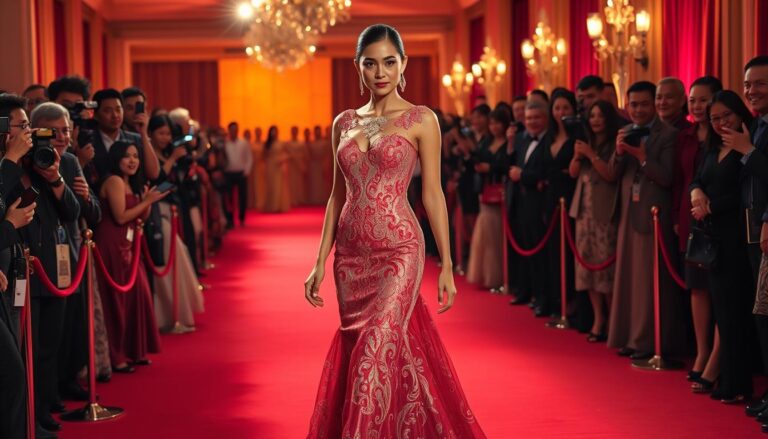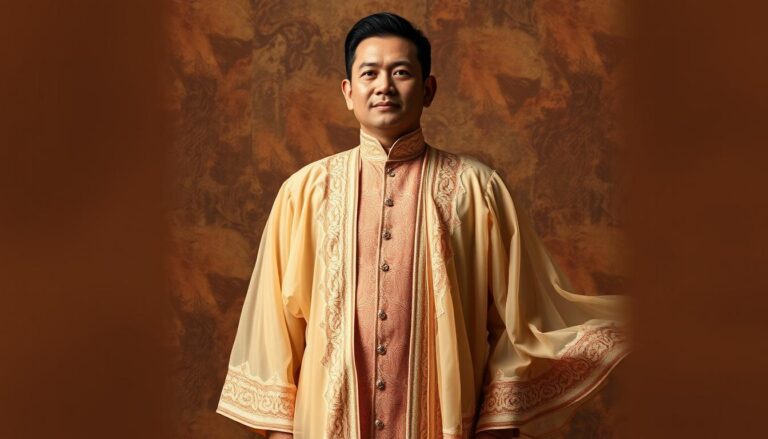Evolution of Filipino Fashion in Modern Culture

Clothing in the Philippines tells a story. For centuries, garments have blended indigenous craftsmanship with outside influences, creating styles that honor heritage while embracing change. From handwoven textiles to sleek modern designs, every stitch reflects a nation’s journey.
Early attire prioritized practicality, using local materials like pineapple fiber and abacá. Spanish rule introduced intricate embroidery and structured silhouettes, seen in iconic pieces like the barong tagalog. Later, American trends brought casual wear like denim into everyday life. Today, designers merge these layers of history with global aesthetics, producing looks worn on runways and streets alike.
What makes these trends unique? They act as living records. The terno sleeve, inspired by Spanish-era dresses, now graces modern gowns. Even accessories, like beaded necklaces mimicking tribal patterns carry cultural pride.
Key Takeaways
- Clothing styles reveal centuries of cultural exchange and adaptation.
- Spanish and American colonial periods left lasting impacts on design.
- Traditional garments like the barong tagalog remain symbols of national identity.
- Modern designers balance global trends with local craftsmanship.
- Accessories and fabrics often incorporate indigenous artistic techniques.
Historical Foundations of Filipino Fashion
Long before colonial influences reshaped its aesthetic, the archipelago’s clothing traditions emerged from necessity and artistry. Early communities relied on nature’s bounty—abacá, pineapple fibers, and cotton—to craft breathable fabrics suited to the tropical climate. These materials weren’t just practical; they became canvases for intricate patterns symbolizing tribal identities.

Indigenous Roots and Early Textiles
Weavers transformed raw fibers into vibrant textiles using techniques passed down for centuries. The sombrado method, which layers threads to create gradient effects, remains a hallmark of traditional Filipino fashion. Garments like the tapis, a wrap-around skirt, showcased geometric designs tied to regional culture. Even today, these motifs inspire modern accessories and runway pieces.
Climate Adaptations and Natural Ornamentation
Heat and humidity shaped early clothing choices. Loose silhouettes allowed airflow, while plant-based dyes provided color without heavy layers. Shells, seeds, and beads adorned garments, merging utility with artistry. This approach to style laid the groundwork for today’s fusion of function and beauty in Filipino fashion.
| Pre-Colonial Feature | Modern Adaptation |
|---|---|
| Handwoven abacá fabric | Piña-silk blends in formal wear |
| Geometric tribal patterns | Abstract prints on casual clothing |
| Tapis silhouette | Asymmetric skirt designs |
Designers still draw from these ancient practices. Competitions like Balik Saya reinterpret the baro’t saya, proving that foundational style elements remain timeless. By honoring these roots, Filipino fashion maintains its distinct voice in a globalized world.
Spanish Colonial Impact on Filipino Attire
Spanish rule reshaped Filipino identity through attire, blending European elegance with local craftsmanship. Garments became markers of social status, merging Catholic modesty with tropical practicality. Two iconic pieces—the baro’t saya and barong tagalog—emerged as symbols of this cultural fusion.

The Emergence of the Baro’t Saya and Barong Tagalog
Women’s baro’t saya combined a loose blouse (baro) with a flowing skirt (saya). A sheer pañuelo scarf covered the shoulders, while a tapis overskirt added modesty. Men’s barong tagalog, woven from pineapple fiber, featured delicate embroidery on translucent fabric, a style still worn at formal events today.
These garments weren’t just clothing. They reflected colonial hierarchies. The barong’s thin material ensured laborers couldn’t conceal weapons, while elites adorned theirs with intricate calado lacework. Over time, these designs became badges of national pride.
Transformation in Women’s Traditional Styles
Spanish ideals transformed women’s dress into displays of refinement. The Maria Clara gown, named after a literary heroine, added bell-shaped sleeves and ornate beadwork. Skirts narrowed into trumpet silhouettes, emphasizing grace over mobility.
Fabrics like piña-silk and jusi elevated everyday wear into art. Embroidery patterns drew from both floral European motifs and geometric tribal designs. This blend birthed the terno, a unified gown with winged sleeves that remains a cultural icon.
Centuries later, these innovations define traditional Filipino style. From presidential inaugurations to festivals, colonial-era clothing still whispers stories of resilience and reinvention.
American Influences and Transitional Styles
The early 1900s marked a seismic shift in Philippine clothes, as Western ideals reshaped daily wardrobes. American colonial rule introduced ready-to-wear garments and factory-made textiles, creating a bridge between tradition and modernity.

Traje de Mestiza and Casual Western Trends
Elite women embraced the Traje de Mestiza—a sleeker version of Spanish-era dresses. Butterfly sleeves replaced bulky fabrics, while ornate skirts mirrored Edwardian design. This transitional outfit became the blueprint for the modern Terno, later adopted as formal national attire.
Working-class Filipinos adopted denim jeans and cotton shirts from U.S. soldiers. These practical items merged with local styles, artisans added banig weave patterns to jackets, while barong-inspired collars appeared on Western shirts. “Jeans became canvases,” noted historian Ambeth Ocampo, “showing our knack for reinvention.”
Fusion of Eastern and Western Fashion Elements
The 1920s saw women pairing flapper-style drop waists with hand-embroidered piña shawls. Men’s Americana suits featured tropical-weight linens instead of heavy wool.
By the 1930s, department stores sold ready-made clothes alongside traditional textiles. Designers began using geometric ikat patterns on A-line dresses, merging ancestral motifs with modern trends.
Mid-Century Fashion Revolution
The 1950s and 1960s brought seismic changes to wardrobes as global trends merged with local creativity. Designers balanced wartime practicality with peacetime optimism, crafting styles that celebrated both structure and freedom.
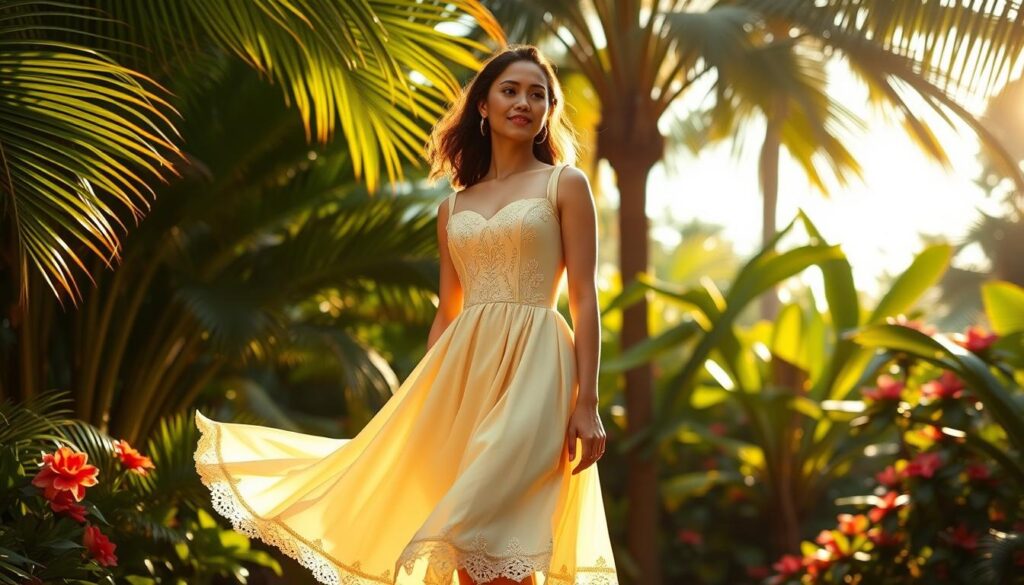
Post-War Elegance and the New Look
Christian Dior’s 1947 “New Look” reshaped global fashion. Its cinched waist, full-circle skirt, and padded hips reached Manila through imported magazines. Local dressmakers adapted these elements using piña fabric, creating tea-length dresses with butterfly sleeves. “It wasn’t just a look, it was hope stitched into fabric,” observed designer Patis Tesoro.
British Pop Culture and the Miniskirt Trend
By the 1960s, British youth culture sparked a rebellion. The miniskirt arrived via films and vinyl records, challenging traditional hemlines. Filipino teens paired these short skirts with dresses featuring bell sleeves or mandarin collars. This decade also saw puffed sleeves shrink into cap styles for easier movement.
| Global Trend | Filipino Adaptation |
|---|---|
| Dior’s full skirt | Layered piña overskirts |
| Mod shift dresses | Embroidered geometric necklines |
| Mini skirt | Knee-length versions with side slits |
These innovations laid groundwork for today’s styles. The waist-defining cuts evolved into bodycon dresses, while bold sleeve designs remain staples. Though rooted in a transformative decade, these mid-century ideas still shape modern closets.
Retro Revival: 1970s to 1990s Fashion Trends
Fashion cycles back like a favorite vinyl record. The late 20th century saw old trends reborn through radical culture shifts. From flower power to angsty grunge, these decades redefined what cool meant in everyday clothes.
Embracing Hippie Culture and Bell Bottoms
The 1970s brought rebellion to wardrobes. Men traded stiff suits for flowy shirts and flared jeans. Women’s dresses flowed like maxi skirts, often paired with crochet vests. Bell bottoms became universal, a symbol of unity between genders and generations.
Local markets buzzed with imported bandanas and hand-beaded accessories. “We weren’t just wearing clothes,” recalled designer Lulu Tan-Gan. “We wore ideals—peace, freedom, defiance.” This era proved fashion could be both protest and poetry.
Grunge Influence and Casual Attire in the 1990s
Nirvana’s raspy chords echoed in Manila’s streets. Teens adopted ripped jeans and oversized flannels—a stark contrast to polished 1980s style. Men’s plaid shirts hung loose, while women layered slip dresses over graphic tees. Comfort trumped formality.
Thrift stores became treasure hunts. A 1994 Philippine Star article noted: “Grunge isn’t a trend—it’s a mindset.” This rejection of perfection birthed a raw, authentic aesthetic still seen in today’s streetwear.
| 1970s Staples | 1990s Essentials |
|---|---|
| Wide-leg denim | Distressed jeans |
| Tie-dye shirts | Band logo tees |
| Platform shoes | Combat boots |
These retro waves never fully receded. Modern clothes often nod to grunge’s edge or hippie ease—proof that bold style choices outlive their decades.
Modern Transformations in the 2000s and 2010s
The digital age rewrote fashion’s rulebook. Social media platforms like Instagram became virtual runways, connecting Filipino teens to Tokyo streetwear and New York hypebeast culture overnight. Suddenly, a selfie could spark a trend or revive a forgotten tradition.

Social Media and Teen Fashion Shifts
Platforms like IG Live turned closets into content hubs. Teens mixed clothing from global brands like Anti Social Social Club with local barong-inspired jackets. Streetwear became a language of rebellion and belonging. “We didn’t just follow trends—we hacked them,” noted designer Bam Barcena.
Digital culture accelerated trend cycles. A TikTok dance challenge could make neon pieces sell out within hours. Yet this speed also fueled nostalgia. Vintage terno sleeves reappeared on cropped hoodies, proving old motifs could feel fresh.
Mixing Traditional Elements with Contemporary Trends
Designers like Cary Santiago sliced through conventions. They layered piña fabric over metallic textiles or paired tribal beadwork with minimalist silhouettes. Events like TernoCon (2017) turned heritage into high art, with winged sleeves redesigned for cocktail dresses.
Boutique labels like Fruition redefined luxury. Their pieces merged handwoven hablon with laser-cut leather—a nod to craftsmanship and innovation. Even global collabs gained local flair. Virgil Abloh’s Louis Vuitton x Nike series featured women’s sneakers embroidered with banig patterns.
This era proved tradition isn’t static. By threading history through hashtags and hybrid clothing, Filipino fashion claimed its seat at the global table.
Evolution of Filipino Fashion in Modern Culture
Global runways now spotlight Manila’s creative pulse. Designers weave ancestral techniques into contemporary clothing, crafting pieces that honor heritage while pushing boundaries. From New York lofts to Tokyo boutiques, these creations redefine what modern style means.
Contemporary Global Influences and Local Adaptations
Narra Studio’s embroidered denim jackets merge traditional hand-stitching with streetwear edge. Their piña-cotton blends drape like silk but withstand urban commutes. This approach mirrors a broader shift—using sustainable local fabrics to meet global fashion demands.
Social media accelerates cross-cultural exchanges. A TikTok video might show a barong redesigned as a cropped blazer, sparking instant trend waves. Platforms like IG Live let designers showcase clothing that pairs tribal beadwork with minimalist silhouettes.
Innovative Designers and Emerging Trends
Mark Bumgarner reimagines the terno sleeve as sculptural accents on cocktail dresses. His pieces balance historical reverence with wearable modernity. Meanwhile, Ternocon’s annual competition challenges creators to reinterpret the butterfly sleeve using futuristic materials like neoprene.
- Digital storytelling: Brands use AR filters to showcase how hablon textiles are woven
- Gender-fluid designs: Traditional baro’t saya shapes adapted for all bodies
- Eco-conscious practices: Upcycled banig mats transformed into statement bags
These innovations prove cultural style isn’t static. By threading heritage through modern design, Filipino creators craft a fashion language that resonates worldwide—one stitch at a time.
Celebrating Craftsmanship: Artistry and Innovation in Filipino Fashion
Behind every stitch lies generations of skill. Filipino artisans transform raw materials into pieces that blend ancestral wisdom with modern demands. Their work bridges tradition and tomorrow, proving craftsmanship remains vital in fast-paced attire markets.
Handcrafted Shoes and Premium Fashion Accessories
Brands like FELIX redefine luxury with chukka boots shaped by hand. Artisans layer abacá fibers over leather, creating soles that mold to feet. Each pair undergoes 200+ steps—from dyeing with natural pigments to precision stitching. “Comfort isn’t an afterthought,” says designer Mara Piñon. “It’s woven into every layer.”
Tarsimoji mules showcase this ethos. Woven banig patterns adorn vegan leather, merging cultural motifs with urban practicality. These pieces thrive in boardrooms and cafes alike, balancing modesty with bold statements.
The Mariqueño Style: Sustaining Cultural Heritage
This aesthetic reimagines rural elegance for global tastes. Designers pair streamlined silhouettes with hand-embroidered calado lace, a nod to Spanish-era attire. Earth-toned fabrics highlight sustainable practices, while asymmetrical cuts appeal to modern minimalists.
Butterfly sleeves evolved too. Once symbols of colonial formality, they now grace cocktail dresses as delicate origami folds. Designers like Len Cabili use lightweight piña to keep them airy yet structured. This fusion honors history while embracing today’s love for movement and modesty.
From footwear to formalwear, Filipino designers prove innovation grows from reverence. Their creations don’t just clothe bodies—they carry stories stitched in time.
Conclusion
Threads of tradition and innovation weave through every garment in the Philippines’ sartorial story. From the earthy tapis skirts of ancient weavers to sleek terno gowns on global runways, each piece carries centuries of culture in its folds. The barong tagalog’s delicate embroidery still graces formal events, while butterfly sleeves evolve into bold architectural shapes.
Today’s designers honor this legacy by blending ancestral techniques with urban edge. Lightweight piña fabric pairs with metallic accents, and tribal beadwork adorns minimalist clothing. These creations aren’t just trends—they’re testaments to a people who reshape their history without erasing it.
As the Philippine apparel market grows, its style narrative gains global resonance. Whether through gender-fluid baro’t saya or upcycled banig accessories, Filipino craftsmanship proves timeless. Every stitch whispers a challenge: to wear culture proudly, yet leave room for reinvention.
Look closer. Behind each garment lie hands that spin, dye, and stitch—bridging decades with every thread. This is fashion as living history, where the past isn’t preserved but reimagined. And that, perhaps, is the most Filipino look of all.

